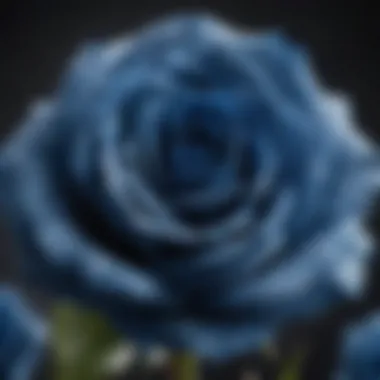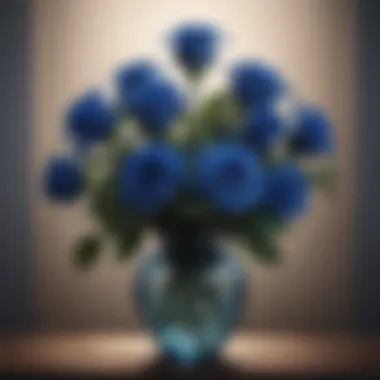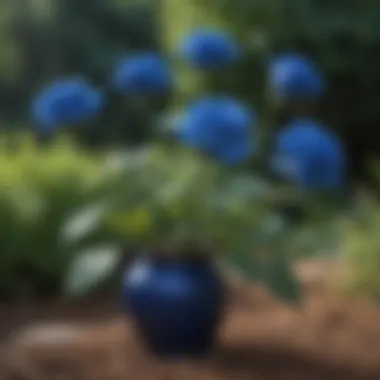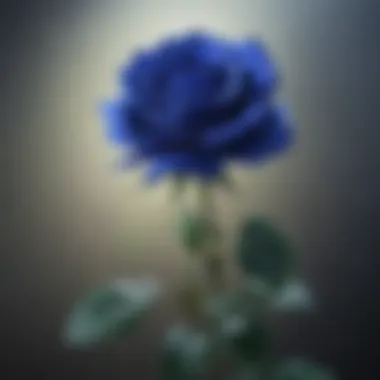Real Blue Roses for Sale: A Deep Dive into Their Wonders


Intro
The exploration of real blue roses establishes a vivid intersection between horticulture and human aspiration. Often associated with rarity and mystique, these flowers have piqued the interest of botanists and floral enthusiasts alike. While traditional rose varieties boast familiar colors, the question of a true blue rose's existence transcends simple classification. This discourse aims to offer an informed overview of the botanical journey needed to produce blue roses and the implications of their accessibility in the marketplace.
Understanding blue roses means comprehending both the science behind their cultivation and the emotional connotations they hold in various cultural contexts. From their intricate genetic modifications to their symbolic associations with the unattainable, engaging with blue roses is more than merely an aesthetic experience.
As we delve into this topic, it becomes evident that the botanical science encompasses decades of hybridization attempts and extraordinary life cycles that merit exploration. Additionally, scrutinizing cultural significance reveals how blue roses can symbolize enchantment, mystery, and hope for the improbable. Therefore, navigating through the current marketplace highlights trends in supply and demand alongside consumer interest. Never forgetting the potential for future developments in horticulture, we must also remain attentive to advancements that might soon shift perceptions regarding these captivating blooms.
This guide comprehensively outlines the various nuances associated with real blue roses, aiming to deepen the transformative experience for those interested in acquiring these stunning floral specimens.
Botany of Blue Roses
Intro to Blue Roses
The journey begins with carefully exploring the botany of blue roses. Unlike other commonly found roses, true blue blooming types do not naturally occur due to the absence of the pigment delphinidin. Historically, various horticulturists and scientists have embarked on a quest to engineer a blue rose.
This journey incorporates traditional hybridization methods alongside groundbreaking genetic modification, further illustrating commitment to this endeavor. The commercial blue rose available today mainly arises from genetic manipulation techniques that allow the gene responsible for the blue tint to derive primarily from pansies.
Physical Characteristics and Appearance
Blue roses are known for their captivating visual appeal. They inherently combine delicacy with intrigue. Physical features include:
- Multi-layered petals, often exhibiting a gradient of pink or purple tints when viewed from different angles.
- Sturdy stems, indicating resilience and potential for longevity when cut.
- Luscious green foliage, which provides a contrasting backdrop to the intricate floral hues.
Not unlike traditional varieties, these specific blooms also vary regarding size and potential garden use, broadening the appeal across various preferences.
Current Marketplace Overview
The demand for blue roses demonstrates a pronounced interest in unique flower varieties. While sometimes available in select florists and specialty shops, sourcing these roses often involves online vendors. Prices can fluctuate significantly, reflecting both quality and availability.
Popular Vendors
Often, the question that arises is where to procure these distinct roses. Some well-regarded vendors include, but are not limited to:
- David Austin Roses
- Ty Ty Nursery
- Plants Express
While browsing for these roses, potential buyers should be vigilant regarding reviews and shipment policies to ensure satisfaction. Full appreciation of one's investment in blue roses inherently requires byte research alongside customer experiences.
It’s crucial to understand that while blue roses possess extraordinary aesthetic appeal, their initial craze began as a reflection of a journey, deeply rooted in science, and unfulfilled desire.
The exploration into blue roses continues, shedding light on market trends and focusing on future horticultural endeavors, enabling perennial cultivation options, assuring the vibrant colors remain accessible for generations ahead.
This article aims to navigate a comprehensive journey from incorporating historical significance to market availability, thereby emphasizing the enduring appeal of these unique floral specimens.
Prelims to Blue Roses
Blue roses are a remarkable topic of interest in both horticulture and symbolism. Their unique characteristics set them apart in the realm of flowers. They do not exist in nature, which adds to their allure. In this context, it becomes relevant to explore their definition, historical significance, and the intricacies surrounding their cultivation.
Definition and Characteristics of Blue Roses
Blue roses are a fascinating creation, differing from traditional rose varieties. Unlike red or white roses, which are found in nature, blue roses have been the subject of scientific ingenuity. Due to their absence in nature, blue roses typically have a distinct hue coming from genetic manipulation or dyeing processes. Understanding these characteristics is critical for anyone looking to appreciate or acquire these unique flowers.
They vary significantly in shade. Some may have a faintly lavender appearance, while others exhibit striking rich blue. Their petal structures can vary too, creating a distinctive look that lovers of florals find captivating. Additionally, blue roses tend to symbolize mystery and the unattainable because of their unusual color. Thus, the characterization of blue roses goes beyond mere aesthetics, unlocking layers of cultural meanings and appeals.
Historical Context and Significance
The history of blue roses is steeped in myth and innovation. For centuries, blue roses have represented various themes in cultures worldwide. In literature and art, they have been symbols of unattainable goals or desires. Such significance can be traced back to folklore and romances where these flowers invoke mystery.


Furthermore, the pursuit of creating real blue roses has been a long-standing quest among botanists. Initiatives to create these blooms involved genetic manipulation, showcasing an intersection of science and nature. This endeavor in horticulture reflects broader themes in human creativity, ambition, and the eternal quest to make the impossible happen. Successfully producing blue roses fundamentally shifted how we perceive and appreciate floral varieties, emphasizing a relationship between human ingenuity and botanical science.
In summary, a thorough understanding of the definition, characteristics, and historical context of blue roses primes enthusiasts for deeper exploration in subsequent sections of this article. Through their captivating presence, these flowers invite not just aesthetic appreciation but also an inquiry into the advancements they inspire within horticultural practices.
Botanical Science Behind Blue Roses
The exploration of blue roses delves into the intricate botanical science that underpins their unique existence. Understanding this science is essential for appreciating how these roses come to be, their development process, and the challenges associated with their cultivation. This section addresses genetic engineering, hybridization techniques, and alternative approaches, illuminating how each contributes to producing real blue roses.
Genetic Engineering and Hybridization
Definition of Genetic Engineering
Genetic engineering refers to the manipulation of an organism’s DNA to achieve desired traits. In the context of blue roses, genetic engineering allows for the introduction of blue coloration genes found in other plants.
This method represents a significant advancement in horticulture. Its key characteristic is precision, as specific genetic alterations can lead to notable outcomes, which support the goal of developing true blue roses rather than relying solely on natural methods.
However, there are disadvantages, too. The ethical implications and public perceptions about genetically modified organisms (GMOs) can be barriers to their acceptance in some markets.
Methods of Hybridization
Hybridization encompasses cross-breeding two or more plant varieties to produce a new one with specific desirable features. For the blue rose initiative, hybridization can combine existing rose colors and the characteristics of hardiness.
One prominent advantage of hybridization is its long-standing tradition in horticulture. Many successful flowers are results of such methods. Nevertheless, the unique aspect of hybridization is its reliance on natural reproductive mechanisms. It often requires meticulous breeding processes and can take years to yield desirable results or achieve a blue hue.
Success Rate of Genetic Techniques
The success rate of genetic techniques in plant biotechnology can vary significantly depending on factors such as the plant species involved and specific genetic goals. The advantages of modern genetic engineering shine through in creating cultivars that would normally not exist in nature. Moreover, the adoption of scientific methods ensures more consistent results in coloration than traditional techniques.
However, challenges persist. Many efforts might yield unexpected results beyond merely modifying color, creating unpredictability in the process. Understanding these factors is essential for those passionate about cultivating blue roses.
Natural Alternatives and Misconceptions
Red Roses and Dye Techniques
The use of red roses treated with dyes highlights a natural method for achieving a semblance of blue roses without genetic manipulation. The primary technique involves introducing dyes into the water the roses absorb, leading to a color shift.
Its appeal lies in its simplicity and quick turnaround time, allowing for instant blue roses without the long wait associated with breeding or genetic modification. However, a significant disadvantage is the lack of permanence in dyeing methods. Once the petals dry or the flowers wilt, the color quickly fades, leaving only the natural hue.
Color Modifications in Other Flowers
Color modifications across various flower species serve as another avenue for understanding horticultural practices when striving to achieve the elusive blue rose. Techniques such as watering petals with different-colored solutions have yielded colored blooms in flowers like hydrangeas.
This method provides insight into the practicality of extending blue hues within domestic gardening efforts. While other flowers can visibly display attractive colors based on environmental factors and treatment, this also emphasizes that not all the color variations can result in the true blue of a rose, which sets an apparent limit on prospects for flower enthusiasts aiming for that ideal shade.
Knowing the ins and outs of these alternatives is vital for making informed decisions when pursuing real blue roses. It also can reduce misconceptions surrounding the methods that may not guarantee success in achieving the desired aesthetic quality that blue roses symbolize.
Cultural Significance of Blue Roses
Cultural significance of blue roses extends far beyond mere aesthetic appeal. Their presence in various forms of art and their adoption in ceremonial practices mark distinct cultural narratives. This section illuminates these elements, emphasizing the profound connections people have with blue roses across different contexts.
Symbolism in Literature and Art
Examples in Poetry
In poetry, blue roses often symbolize the unattainable or the elusive aspects of life. Many poets use this flower to express feelings of longing and desire, leveraging its rarity to convey emotional depth. The key characteristic of using blue roses in poetry is the way it encapsulates complex themes such as despair or hope. This theme resonates well in literary works that explore emotional struggles, thereby enhancing the poetic narrative.
The unique feature of blue roses in poetry is their ability to connect readers to feelings that might otherwise go unexpressed. From Shakespearean sonnets to contemporary poetry, these roses illustrate beauty wrapped in desire—a beneficial choice in numerous literary pieces. Their power lies in reflecting profound sentiments that transcend mere floral descriptions, offering a deeper resonance with these unique flowers.


Representation in Visual Arts
The representation of blue roses in visual arts carries its own cultural weight, often associated with notions of mystery and the unknown. Artists have depicted this flower to symbolize themes that outline life's delicate balance between hope and sorrow. A significant characteristic of blue roses in visual arts is their unusual form and color which draw the viewer’s attention, making them a popular subject.
Visually, the unique feature of a blue rose stands out because of its strikingly surreal quality. They often serve as a vehicle for artists, conveying existential thoughts and inviting interpretations. This representation provides an advantage in drawing viewers into a contemplation of their meanings, enthralling people with their complex symbolism without simply being part of a still life.
Use in Ceremonies and Celebrations
Adoption in Weddings
In the context of weddings, blue roses are frequently adopted to exemplify rarity, innovation, and new beginnings. Couples often seek blue roses to differentiate their floral arrangements, as these flowers stand for the uniqueness of their love. The essential quality of blue roses in this setting underscores their appeal: they are neither entirely blue nor completely ordinary, creating symbolism unique to the couple’s bond.
Such adoption also has a unique feature. In obtaining blue roses, couples often showcase effort and creativity, setting their ceremonies apart visually and thematically. This characteristic can often put couples at risk of logistical challenges when obtaining real blue roses, impacting the celebration significantly, especially if availability is scarce during peak seasons.
Role in Funerals and Memorials
Blue roses also hold a poignant place in funerals and memorials, representing the enduring presence of loved ones and the memory they leave behind. Their usage creates an opportunity for honoring those who have passed and signifying hope for peace beyond mortality. The key aspect of blue roses in such contexts is the depth of emotion they portray—balancing commemoration with the celebration of life.
The unique feature lies in their ambiguous nature; while they symbolize loss, they can also reflect compassion and comfort for those grieving. This dual purpose in emotional narratives makes them a suitable choice, though their rarity presents challenges regarding accessibility and cost. Those opting for blue roses must navigate the delicate balance between meaning and practicality when planning such memorial services.
Market Availability of Real Blue Roses
The market availability of real blue roses is a central aspect of this article. Understanding the availability informs potential buyers about their options. Blue roses are intriguing because they are not naturally occurring. They need specific processes to become available for sale. This section sheds light on where and how one can procure these flowers, while addressing factors impacting their market existence.
Current Vendors and Regions
Local Florists
Local florists often play a vital role in the availability of real blue roses. They are familiar with their communities, creating a personal touch in sales. A significant benefit of local florists is their ability to provide freshly cut blue roses. This ensures customers receive high-quality, vibrant flowers. Furthermore, these florists might offer the experience of seeing the flowers before purchase. However, geographical limitations could restrict availability in certain regions. Additionally, the price can be higher at local shops compared to online options, creating a trade-off between accessibility and personal service.
Online Plant Nurseries
Online plant nurseries have become a noticeable platform for acquiring blue roses. They provide substantial access to a wider audience beyond geographical boundaries. One helpful characteristic is the ability to browse multiple vendors at once from comfort of one's home. Often, these nurseries specialize in unique varieties, including genetically modified ones. However, buying online can be less personal. Customers may not see the roses until arrival, raising concerns about quality. Accurate descriptions and customer reviews become crucial in this setting.
Global Distribution Channels
Global distribution channels expand the market for real blue roses significantly. This framework can connect growers from different regions to distributors worldwide. The broad reach of these channels helps ensure availability to consumers who cannot easily locate them locally. A key aspect is the reliance on detailed supply chain logistics. Some distributors may specialize in exclusive or rare flowers. On the downside, global shipping could lead to delays and handling damage that affect the roses' quality. Thus, balancing convenience against the risk of diminished freshness becomes vital for consumers considering global sources.
Pricing Dynamics
Understanding pricing dynamics is also essential, as it directly influences the purchasing choices. The cost of blue roses can vary considerably due to different factors. Its not uncommon for prices to be higher than many traditional flowers, making budgeting a critical consideration.
Factors Influencing Prices
Several factors influence the prices of blue roses in the market. The method of cultivation holds a lot of weight. For instance, naturally cultivated floral varieties usually command different pricing compared to genetically engineered ones. Seasonal demand also affects costs, with certain times of the year likely presenting higher rates. Likewise, transportation and storage determine final pricing, as longer distances or poor conditions can inflate costs.
Comparative Analysis with Other Flower Types
Conducting a comparative analysis with other flower types is beneficial to understand the market positioning of blue roses. Comparing them to roses of other colors can reveal insights regarding price perception and consumer preferences. Generally, blue roses are priced above standard red roses, possibly due to their rarity. This distinction helps buyers recognize the investment involved in acquiring this unique floral specimen.
Purchasing Considerations
When considering the purchase of real blue roses, various factors come into play. Understanding these factors is vital for acquiring high-quality specimens. The market for blue roses has intensified in recent years due to their unique aesthetics and symbolic meanings. Therefore, knowing what to look for when purchasing can enhance overall satisfaction with the purchase, which will ensure that buyers get the best possible experience.
Quality Indicators
Signs of Freshness


Freshness is crucial when selecting blue roses. Buying flowers that are fresh leads not only to aesthetic appeal but also to longevity. The key characteristic to look for is vibrant colors and firm petals. If the petals appear wilted or discolored, this suggests age and diminished freshness.
Another unique feature of fresh blue roses is their regenerated fragrance. A strong, pleasant scent indicates vitality, which is why it is a beneficial trait when making a purchase. However, experienced buyers ought caution with their decision based on artificial fragrances which some sellers may apply to make old roses smell appealing. Therefore, understanding freshness ensures that consumers are investing in blooms that last and maintain beauty.
Storage and Transportation Conditions
Equally significant are the storage and transportation conditions before reaching the consumer. Proper practices during transit preserve the quality of blue roses, ensuring they arrive in pristine condition. Ideally, these roses should be transported in a climate-controlled environment to prevent temperature stress, which helps maintain hydration.
A defining feature here is the use of protective packaging. A well-packed floral arrangement reduces physical damage during transit. Ensuring optimal storage while on display is also vital. Improper storage might lead to wilting or rapid decay after purchase. Buyers should make sure to buy from vendors who prioritize temperature and handling, thereby securing higher quality blooms upon arrival.
Certifications and Sustainability
Organic Certifications
Consumers often seek organic certification when purchasing blue roses. This aspect is important because it promises that the flowers are grown without harmful pesticides or synthetic fertilizers. The key characteristic of organic blue roses lies in their cultivation methods. Certified organic practices contribute to a healthier environment, making them a beneficial choice for environmentally conscious consumers.
An important unique feature of these certifications is that they reflect growers' commitment to sustainability. Flowers with organic labeling generally fetch a higher price but offer lasting advantages like environmental benefits and fewer health concerns for consumers following proper cultivation methods, which leads to better overall quality.
Impact of Cultivation Practices on Biodiversity
Purchasing considered blue roses also brings attention to cultivation practices affecting biodiversity. The significance of these practices cannot be understated, as they influence the ecological balance. Healthy cultivation methods favor plant diversity and contribute to local ecosystems, making such roses a popular and ethical choice for consumers.
Unique features of these sustainable practices include the preference for pollinator-friendly habitats. They create an environment that supports not just individual plants but a ecosystem where multiple species thrive. This ecological impact provides additional benefits, encouraging consumers to embrace sustainable floral purchases and appreciate the role they play DIY.Perceptions about beauty become more profound with an understanding of how choices impact broader worlds.
Future Perspectives on Blue Roses
The future of blue roses is an intriguing subject, connecting scientific advancement and market trends. These flowers captivate not just for their rarity but also for potential developments in cultivation and consumer behavior. Exploring future perspectives provides insight into the sustainability, availability, and aesthetic value of blue roses.
Advancements in Plant Biotechnology
Promising Research Directions
Advancements in plant biotechnology focus on enhancing the traits of blue roses. Gene editing techniques like CRISPR are pivotal in this regard. This method allows scientists to make precise genetic modifications. The main benefit is the possibly increased vibrancy of blue pigmentation, which can attract more attention. Unique research direction includes understanding the biochemical pathways that lead to color expression. This can positively impact the appeal of blue roses and drive interest in uniquely colored plants.
Potential New Varieties
Developing new varieties is integral for broadening the market for blue roses. Ongoing plant medical studies aim to create strains that can withstand diseases better and adapt to climate changes, which is essential. The characteristic difference with potential new varieties could be resilience and vibrancy. Their uniqueness could expand consumers' choices, creating increased demand for diverse options in the market. One potential drawback is the long cultivation time needed before a new variety may become commercially available, which could challenge timeliness and reduce the eagerness of some buyers.
Trends in Consumer Demand
Influence of Social Media
The influence of social media has become paramount in shaping floral trends, including blue roses. Platforms allow florists and consumers to share visually captivating images, instantly sparking interest. Visual appeal on platforms like Instagram and Facebook enhances exposure for blue roses. Use of hashtags can reach broader audiences, optimizing promotions around specific occasions. However, the fast-paced nature of social media may sway trends abruptly; one day's trend could quickly fade.
Changing Preferences in Floral Arrangements
Changing preferences in floral arrangements reflect consumers evolving aesthetics. Custom arrangements employing unique varieties like blue roses are becoming more desired. People are increasingly seeking personalized expressions through floral choices, making this trend imperative. The distinct nature of blue roses caters perfectly to such preferences oftentimes granting a significant spotlight in events like weddings. Some drawbacks include potential limits in availability for specific arrangements, which may frustrate planners focused on vision.
"The creative exploration within floral arrangements unveils remarkable depth in consumer choices, particularly attracting those desiring beauty paired with uniqueness."
Finale
The study of real blue roses is a multidimensional subject that weaves together science, culture, and commerce. Understanding the critical elements covered in the article offers insight into not only the allure of these unique flowers but also their place in botanical advancements and consumer trends.
Recap of Key Points
- Definition and characteristics: Blue roses are often created through genetic engineering and hybridization, setting them apart from traditional roses.
- Cultural significance: From art to ceremonies, blue roses represent various themes, often associated with the unattainable and transcendent.
- Market dynamics: Various vendors, ranging from local florists to online nurseries, influence the availability and pricing.
- Considerations for purchase: Factors like quality indicators and sustainability certifications are essential when acquiring blue roses.
- Future perspectives: Advances in biotechnology promise exciting developments in new varieties and adjust to shifting consumer desires influenced by social media.
“Real blue roses are not just flowers; they embody innovation, culture, and the future of horticulture.”
Final Thoughts and Recommendations
In navigating the complex landscape of blue roses, readers should take into account the agricultural practices accompanying their production and procurement. Understanding this floral specimen's background elevates one's appreciation for its beauty and symbolic value. When seeking to acquire blue roses,
- Ensure the vendor has a reputation for high-quality and sustainably sourced blooms.
- Investigate their certifications concerning organic practices and environmental impact.
- Consider emerging trends in floral arrangements that incorporate varied colors, inclusive of these unique roses. By fostering a more informed approach, potential buyers can cultivate an enriching experience that extends beyond aesthetics, promoting a deeper connection to the art of horticulture.







